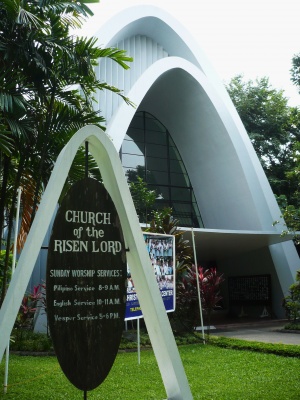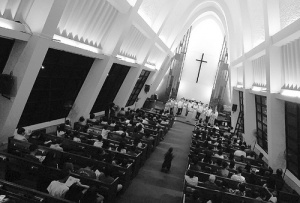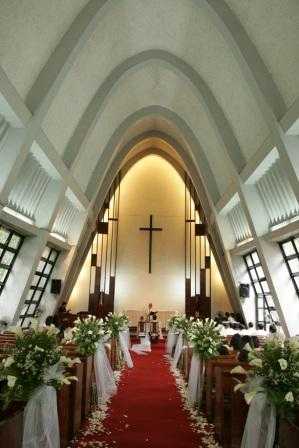Church of the Risen Lord: Difference between revisions
| Line 102: | Line 102: | ||
The church is comprised of a main chapel (Church of the Risen Lord), a student center (Gumersindo Garcia Hall) and a child care center (Christian Child Care Center). | The church is comprised of a main chapel (Church of the Risen Lord), a student center (Gumersindo Garcia Hall) and a child care center (Christian Child Care Center). | ||
====Christian Child Care Center (CCCC)==== | ====Christian Child Care Center (CCCC)==== | ||
The Christian Child Care Center is a school that gives scholarships to children from needy families in university communities. It was originally named Nursery-Kindergarten School when it was started in 1961. | The Christian Child Care Center is a school that gives scholarships to children from needy families in university communities. It was originally named Nursery-Kindergarten School when it was started in 1961.<br /><br /> | ||
Develops instructional policies, curricula, teaching materials and administrative procedures in the operation of the CCCC to ensure that the lessons and instructions given to preschool pupils follow the regulations of the Department of Education and the objective of CRL to enhance the spiritual growth of children within the values of CRL.<br /><br /> | |||
The Christian Child Care Center is a school that gives scholarships to children from needy families in university communities. It was originally named Nursery-Kindergarten School when it was started in 1961.<br /><br /> | |||
The Christian Child Care Center or CCCC, the educational arm of the Church of the Risen Lord will celebrate golden years of service to our Lord and Savior Jesus Christ this year.<ref>"Ministries." UP Church of the Risen Lord. WordPress, 2011. Web. 11 Mar 2012. <http://crl.ukbesthosts.com/ministries></ref> | |||
====Gumersindo Garcia Hall (GG Hall)==== | ====Gumersindo Garcia Hall (GG Hall)==== | ||
The Gumersindo Garcia Hall (most commonly known as the GG Hall) is the student center of the CRL. It was named after Dr. Gumersindo Garcia, the UP Regent who persuaded the UP Administration and UP Regent of Board to allow the building of the Protestant chapel and student center. It was his through his efforts that the chapel and student center was allowed to be built in the university grounds. | The Gumersindo Garcia Hall (most commonly known as the GG Hall) is the student center of the CRL. It was named after Dr. Gumersindo Garcia, the UP Regent who persuaded the UP Administration and UP Regent of Board to allow the building of the Protestant chapel and student center. It was his through his efforts that the chapel and student center was allowed to be built in the university grounds. | ||
Revision as of 08:18, 12 March 2012
Places of Worship
Art Studies 2 THR-2
Prof. Roberto G. Paulino
Espiritu, Angelica E.
Mondarte, Evan Q.
Sarmiento, WillJ C.

The Church of the Risen Lord is a Protestant church located at the University of the Philippines, Diliman, Quezon City. It arose about 50 years ago through a Protestant student group named the Christian Youth Movement (CYM).
Location
The Church of the Holy Sacrifice is located in UP Diliman, along Laurel Avenue, Diliman, Quezon City, Metro Manila, beside the Parish of the Holy Sacrifice and the UP Health Service. <googlemap lat="14.659534" lon="121.07204"></googlemap>
History
Earlier years (Pre-construction of church)
In 1947, when the University of the Philippines was still in Padre Faura, Manila, a group of Protestant students started a movement named Christian Youth Movement (CYM) which aims to “make relevant Christian presence in the university campus”. They sought help from the Philippine Federation of Christian Churches (PFCC), now the National Council of Churches in the Philippines (NCCP).
When the Diliman campus became the main campus of UP in 1949, the UPCYM also transferred to Diliman. With the new university setting, they stayed at a sawali chapel – a chapel made of bamboo and nipa - and shared it with two other religious groups, namely the UP Student Catholic Action (UPSCA) and the Iglesia Filipina Independencia.
Eventually, these three religious groups started to have conflicts among their schedules, like for the Protestant worship services and the Catholic masses. Also, each group started to receive more and more members, making the chapel too crowded to accommodate all of them. So in 1952, the UPCYM launched their own fund drive, for them to be able to build their own Protestant chapel and student center inside the campus. March 16 of that year, they held a concert at the Central Church, Manila, with Ramon Tapales and Flora Zarco-Rivera of the UP Conservatory of Music and Luz Morales of the Centro Escolar University as conductors.
It was during President Vidal Tan's administration that the University granted both religious groups (Protestant and Catholic)to have their respective sanctuaries. By 1953, a portion of land were leased to the Roman Catholic and Protestant Church. Although the land was leased it was stated that the state had no control of the Church or vice versa.[1]
In 1953, Cesar Cancio and his architectural firm presented proposed blueprints for the Church and the student center to the NCCP and the UP Regent of Boards. The following year,1954, the Church of the Risen Lord and the Student Center was built. Its groundbreaking ceremonies were held on February 7 of that year.
About the Church
MISSION
"CRL expects to accomplish this vision by establishing relevant ministries committed to making disciples and leaders for the Lord Jesus Christ ready to proclaim and defend the relevance of His Lordship and Deity, promote unity and understanding of the various philosophies and religions through dialog and cooperation, and bring all believers and members of the church to maturity and fidelity in Christ."[2]
VISION
"We envision that by 2010, CRL becomes a center and driving force and influence for evangelism in UP, church planting in the surrounding communities, and mission-sending to the global community by creating a responsive understanding and clear visualization of God’s purpose in one’s life."[3]
IDENTITY
We are an inter-denominational Christian community, united in discipleship to Christ, ministering in the context of the University of the Philippines, the surrounding communities, and the world; witnessing to the Lordship and Deity of Jesus Christ.[4]

Ministries
University Ministry, Congregation Ministry, UP Christian Youth Movement, Music Ministry, Christian Education and Christian Child Care Center[5]
UP Christian Youth Movement
In 1947, a group of Protestant students in the old Campus of the University of the Philippines in Padre Faura, Manila, led a student movement that sought to have relevant “Christian presence” in the university campus. The group, calling itself the UP Christian Youth Movement (UPCYM), resettled in January of 1949 when the University of the Philippines moved its main campus to Diliman, Quezon City.[6]
Timeline
1954
- February 7, Groundbreaking ceremony for the CRL which was attended by more than 500 people including President Tan[7]
1956
- First CRL constitution drafted
- Christian Women's Fellowship (now Christian Women's Guild) organized
- July 1, the Church Chapel was inaugurated
- December, the CRL held its first Christmas Concert which later became a forerunner for the Traditional Carols by Candlelight.
[8]
1958
- CRL requested for recognition as a local church
- Request was later denied but CRL was still allowed to exist as a STUDENT MINISTRY
1960
- CRL became a place for ecunemical dialougues and place to study the arts, music and social issues that concerns the youth. [9]
1961
- Nursery-Kindergarten School started
1963-1972
- DYNAMIC DECADE: Many new evangelical expressions
- "Passion According to St. Matthew" (1964) and "Passion According to St. John" (1965) marked ecumenical reach-out and participation of both churches (Church of the Risen Lord and Parish of the Holy Sacrifice in the premier state university campus.
1964
- Student Center renamed Gumersindo Garcia Fellowship Hall
1969
- First Filipino chaplain: Rev. Bonifacio Mequi
Architectural structure


The Church of the Risen Lord was designed to have an exterior shape similar to a parabola. This kind of architectural design symbolizes the belief that there are imperfections outside the Christian world and all of our aspirations to be perfect are useless. A characteristic of a parabola is that it has no distinctive peak just like of a triangle and it has no one slope. As we go up the parabola, before we get to the highest peak, we can observe that we eventually go down.
Also, entering in the church represents the desire to partake the God’s Bread of Life, which symbolizes God’s spiritual being. As we continue to go to the chancel (similar to the altar of the Catholics but has no visual representations of holy beings) – the salvation despite the imperfections in the real world, we can observe that the width of the church is tapering and this represents the one true path/direction towards the chancel (the salvation).
Moreover, the seal of the UPCYM group can be seen as an ascending fire or can also be a descending dove. This symbolizes the spiritual connection between God and the human being. The fire is associated to the faith of the human to his creator and the dove represents the love of God for us.
In addition, the overall architecture of the Church provides a light, airy feeling due to the louvres; the large window panels also provides a natural lighting to scatter around the Church. There is also a balcony where the music ministry is situated during service.
The Church has a basilica design and features a concrete shell roof, this time curved like a piece of folded paper. As you enter the church you would first notice the big cross at the center of the altar with no human image, a partly explanation for this is the Protestant belief that Jesus' physical body was glorified and resurrected and no longer resides on the earth therefore the lack of Jesus' physical images. The place provides a solemn and serene atmosphere to worship and provides for its congregation. On the benches are several copies of the Bible, notebooks and pens. The Church is also a popular venue for weddings.[10]
About the Architect
Mr. Cesar Homero Rosales Concio
University Architect who also designed several buildings in the University the Main Library, Palma Hall and Melchor Hall. It was also noted that he designed public buildings such as Insular Life Building, Baclaran Church and the Children’s Hospital. [11]
In 1964, he also won several awards such as Gold Medal Merit which was given by the Philippine Institute of Architectsand the Patnubay ng Sining at Kalinangan Award.[12]
Other parts of the church
The church is comprised of a main chapel (Church of the Risen Lord), a student center (Gumersindo Garcia Hall) and a child care center (Christian Child Care Center).
Christian Child Care Center (CCCC)
The Christian Child Care Center is a school that gives scholarships to children from needy families in university communities. It was originally named Nursery-Kindergarten School when it was started in 1961.
Develops instructional policies, curricula, teaching materials and administrative procedures in the operation of the CCCC to ensure that the lessons and instructions given to preschool pupils follow the regulations of the Department of Education and the objective of CRL to enhance the spiritual growth of children within the values of CRL.
The Christian Child Care Center is a school that gives scholarships to children from needy families in university communities. It was originally named Nursery-Kindergarten School when it was started in 1961.
The Christian Child Care Center or CCCC, the educational arm of the Church of the Risen Lord will celebrate golden years of service to our Lord and Savior Jesus Christ this year.[13]
Gumersindo Garcia Hall (GG Hall)
The Gumersindo Garcia Hall (most commonly known as the GG Hall) is the student center of the CRL. It was named after Dr. Gumersindo Garcia, the UP Regent who persuaded the UP Administration and UP Regent of Board to allow the building of the Protestant chapel and student center. It was his through his efforts that the chapel and student center was allowed to be built in the university grounds.
When Dr. Garcia passed away in April 8, 1964, the student center was renamed Gumersindo Garcia Fellowship Center to dedicate his memory. Later, it was changed to its present name, Gumersindo Garcia Hall or GG Hall, as what is more commonly known to the community.
References
UP Chapel and the Church of the Risen Lord
See Also
- ↑ "Places of Worship." WikiPilipinas: The Hip 'n Free Philippine Encyclopedia. N.p., n.d. Web. 11 Mar 2012. <http://en.wikipilipinas.org/index.php?title=Places_of_Worship_in_UP_Diliman
- ↑ "Who We Are." UP Church of the Risen Lord; U.P. Ecunemical Ministry. WordPress, 2011. Web. 11 Mar 2012. <http://crl.ukbesthosts.com/who-we-are>.
- ↑ . "Who We Are." UP Church of the Risen Lord; U.P. Ecunemical Ministry. WordPress, 2011. Web. 11 Mar 2012. <http://crl.ukbesthosts.com/who-we-are>.
- ↑ . "Who We Are." UP Church of the Risen Lord; U.P. Ecunemical Ministry. WordPress, 2011. Web. 11 Mar 2012. <http://crl.ukbesthosts.com/who-we-are>.
- ↑ . "Who We Are." UP Church of the Risen Lord; U.P. Ecunemical Ministry. WordPress, 2011. Web. 11 Mar 2012. <http://crl.ukbesthosts.com/who-we-are>.
- ↑ . "Who We Are." UP Church of the Risen Lord; U.P. Ecunemical Ministry. WordPress, 2011. Web. 11 Mar 2012. <http://crl.ukbesthosts.com/who-we-are>.
- ↑ "Places of Worship." WikiPilipinas: The Hip 'n Free Philippine Encyclopedia. N.p., n.d. Web. 11 Mar 2012. <http://en.wikipilipinas.org/index.php?title=Places_of_Worship_in_UP_Diliman
- ↑ "Places of Worship." WikiPilipinas: The Hip 'n Free Philippine Encyclopedia. N.p., n.d. Web. 11 Mar 2012. <http://en.wikipilipinas.org/index.php?title=Places_of_Worship_in_UP_Diliman
- ↑ "Places of Worship." WikiPilipinas: The Hip 'n Free Philippine Encyclopedia. N.p., n.d. Web. 11 Mar 2012. <http://en.wikipilipinas.org/index.php?title=Places_of_Worship_in_UP_Diliman
- ↑ "Church of the Risend Lord." Ship of Fools.com. Ship of fools, n.d. Web. 11 Mar 2012. <http://ship-of-fools.com/mystery/2007/1368.html>
- ↑ "Cesar Concio." Philippine Architecture Review. Blogger, n.d. Web. 11 Mar 2012. <http://philarchreview.blogspot.com/2011/08/cesar-concio.html>.
- ↑ "Awards in Architecture." National Commission for Culture and the Arts. N.p., 2011. Web. 11 Mar 2012. <http://www.ncca.gov.ph/about-culture-and-arts/articles-on-c-n-a/article.php?igm=1&i=108>
- ↑ "Ministries." UP Church of the Risen Lord. WordPress, 2011. Web. 11 Mar 2012. <http://crl.ukbesthosts.com/ministries>




